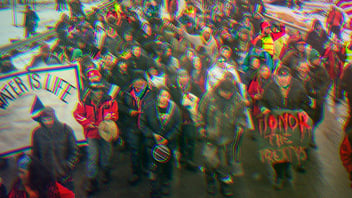Spy Balloons: The Ultimate Distraction
 Image Description: A father and daughter sitting on the grass at night. The dad is pointing at the spy balloon in the sky.
Image Description: A father and daughter sitting on the grass at night. The dad is pointing at the spy balloon in the sky.
In the era of ubiquitous digital surveillance—TikTok stealing your children’s information, data brokers selling your information, Bing telling you to break up with your spouse because it wants to be human and loves you—the nation is fascinated by spy balloons. Let’s dissect the true nature of the modern surveillance state, and at the end I’ll leave you with a chilling personal anecdote to put things in perspective.
Let’s recap what happened. The U.S. warned that a balloon—maybe one with surveillance capabilities—had been flying over the continental U.S. after first drifting over Alaska. That set off wild speculation about the apparent threat, the balloon’s capabilities, and whether China was spying on our underground nuclear silos in Montana. As if no one knows where we keep our missiles.
Naturally, fear-mongering from lawmakers ensued, including from China hawks in both parties, punctuated by those demanding swifter action on America’s floating nemesis. And finally, we got dramatic footage of a U.S. military fighter jet shooting down our sky stalker, sparking condemnation from China, which said the balloon had inadvertently drifted over U.S. airspace—a claim that may actually be true if you consider the weather and jet stream activity in the U.S. at the time. Not to mention, anonymous U.S. officials have since given credence to the wind theory, so it’s not just a convenient talking point coming from the Chinese government. Alas, the “spy” narrative has already taken root, so it’s unlikely most of you have actually heard this alternative theory.
This obsession with Chinese balloons and UFOs obscures something way more sinister: U.S. Surveillance. Incredibly, it’s been a decade since NSA whistleblower Edward Snowden’s blockbuster revelations about widespread surveillance of Americans. While Snowden’s leaks were obfuscated by the mindless and nauseating debate over whether he’s a hero or traitor, his revelations, if you recall, were extraordinary: showing how the U.S. government was not only hoarding our metadata but accessing our private communications.
A decade later, America remains the over-bloated surveillance state it was when Snowden left the United States. As a reminder to the balloon fanatics out there, the United States maintains about 750 military bases across 80 nations. And when you consider its hegemony complex—that’s the part where we overthrow democratically elected regimes, authorize drone strikes in nations we’re not at war with and help coordinate assassinations abroad—America’s influence becomes even more far-reaching.
So, let’s put the Chinese balloon episode into some proper context.
In an apparent attempt at justifying the destruction of the Chinese balloon, the administration has since said that similar Chinese devices have illegally entered the airspace of other nations. To make such a point is to reframe the debate over mass surveillance.
As with most things about our contemporary politics, all paths lead back to decisions that were made after 9/11. According to the Snowden disclosures, U.S. intelligence spending has grown by leaps and bounds. By the time he leaked the NSA documents, intelligence spending had doubled since 2001.
Obviously, we’re all aware of PRISM and the other NSA programs that he disclosed. That those weren’t the only major bombshells speaks to the enormity of America’s surveillance capabilities. According to Snowden: The U.S., ironically, had been hacking into computers in Hong Kong and in China for years; the U.S. spied on its allies, specifically European officials working in DC, and separately, the European Union mission in New York and the embassy in Washington. And, of course, we later learned that the NSA successfully tapped the phone of former German Chancellor Angela Merkel—one of America’s staunchest allies.
Because of the disproportionate attention paid to FISA and Section 215 of the Patriot Act over the years, there’s a good chance most of you have never heard of Executive Order 12333—or “twelve, triple-three” in intelligence jargon. Introduced by Ronald Reagan, the executive order is so overly-broad that civil liberties advocates for decades have called for it to be reformed, or gutted entirely. Essentially, twelve, triple-three gives America’s intelligence agencies—the NSA and CIA, for example—carte blanche to spy on people across the globe, and justifies the quote-unquote “incidental” collection of American data. Since the order was signed by the president, it falls on the Executive Branch to police itself—good luck with that.
Here’s how the Brennan Center described the Reagan-era order, which was updated by George W. Bush in 2008:
“That means it is subject to no statutory constraints whatsoever, and there is no judicial review or oversight. EO 12333 does place some limits on surveillance, but not shockingly, its rules are much more permissive than those Congress established in FISA. Bulk collection is just one example—it’s banned under FISA, but permitted under EO 12333.”
Therein lies the loophole.
The Brennan Center then poses this question: “What stops the CIA from poring through the data looking for Americans’ information? Let’s be honest: nothing.”
Super.
The CIA’s bulk collection program is so secretive that members of the Senate Select Committee on Intelligence have been in the dark. That extraordinary revelation came when the contents of an April 2021 letter from Senators Ron Wyden and Martin Heinrich addressed to the CIA’s director of national intelligence was declassified. In it, the lawmakers expressed concern that the CIA has been secretly conducting its own bulk collection program—something the senators weren’t aware of until the Office of Privacy and Civil Liberties issued a review about twelve, triple-three.
Twelve, triple-three is just one program. We haven’t even scratched the service of the government’s full capabilities and surveillance regime. In March 2017, the organization released a truly astonishing trove of documents from inside the CIA’s Center for Cyber Intelligence about the agency’s hacking tools. Again, the media picked up the story, but it didn’t have staying power—perhaps because it was too complex, or maybe they fell in line with the security state’s assessment that the revelations were a threat to the country.
Here’s, in part, what the Vault 7 documents revealed, according to WikiLeaks:
“By the end of 2016, the CIA’s hacking division, which formally falls under the agency’s Center for Cyber Intelligence (CCI), had over 5,000 registered users and had produced more than a thousand hacking systems, trojans, viruses, and other ‘weaponized’ malware. Such is the scale of the CIA’s undertaking that, by 2016, its hackers had utilized more code than that used to run Facebook. The CIA had created, in effect, its ‘own NSA’ with even less accountability and without publicly answering the question as to whether such a massive budgetary spend on duplicating the capacities of a rival agency could be justified.”
Among the tools it developed was something called “Weeping Angel” that allowed the CIA to turn smart TVs into microphones—even when they appeared “off.” And this didn’t just happen out of Langley. According to Vault 7, the agency uses a U.S. consulate in Frankfurt, Germany as “a covert base” for its hackers covering Europe, the Middle East, and Africa.”
Besides the CIA’s capabilities, local and state law enforcement in the U.S. deploys so much technology that we’re effectively surveilled on a constant basis, thanks to facial recognition technology, license plate readers, Stingray listening devices, and so much more. Famously, the NSA once deployed a massive blimp called the “Hover Hammer”—I kid you not— over the U.S. that measured 62 feet in diameter. The blimp, according to The Intercept, was equipped with a device capable of intercepting wireless communication, including cell phone calls.
So, we’re under constant surveillance, yet much of this is rarely discussed in U.S. media. Unless you closely follow reporting from national security reporters—those that don’t function as stenographers for the security state—you’re likely unaware of how our civil liberties are being eroded. And that’s what the government is counting on.
The Chinese balloon episode—even if it was a spying device—pales in comparison to what the U.S. government has done, and is capable of doing, to people around the world and its own citizens on a daily basis.
Now, here’s the anecdote I wanted to share to really bring this home. Because I know there are those out there who believe in the idea that national security is just there to protect us. In fact, most people don’t have a problem with the U.S. spying on its own citizens because, hey, I have nothing to hide. That’s what a journalist friend of mine years ago thought as well. Her name is Alexa O’Brien.
Alexa is a brilliant and fearless writer who was reporting on the Chelsea Manning military sham trial. She had previously been an organizer for a protest organization created to protest U.S. government overreach. Thanks to some friends in the government, it was revealed to her that her name popped upon the Wikileaks dumps. What she found was terrifying.
Government contractors were casually discussing how easy it would be to link her and her organization to Al-Qaeda as sympathizers, which would classify her as a domestic terrorist under the new Bush era laws that Obama doubled down on. In short, they were planning to frame her as an enemy of the state. At that point, she could have been easily “disappeared” and sent to one of the U.S. “CMUs,” which stands for communication management units. I’m betting you haven’t heard of those either. Well, these are holding facilities that the government can send people they consider threats. Okay. They’re also denied legal counsel. And are not required to disclose your location to family members. Hence the term “disappeared.”
The Executive Branch under George W. Bush, and again under Obama, granted itself extraordinary powers to usurp the legal and constitutional rights of U.S. citizens. It has only itself to answer to. All of this has been codified into U.S. code through multiple authorizations of the National Defense Authorization Act every year since 9/11. The fear among civil rights advocates was that these secret maneuvers would be weaponized. And of course, if they have been…how would we know?
We know this much. Barack Obama prosecuted whistleblowers under the Espionage Act more than every other president combined. Donald Trump spoke brazenly about assassinating people and routinely referred to members of the Press as “enemies of the state.”
The U.S. government has all of our information. And it can do with it what it pleases. So you are to remain wholly compliant.
Look away. Nothing to see here. But please. Do tell me more about those pesky spy balloons.
Here endeth the lesson.
Max is a political commentator and essayist who focuses on the intersection of American socioeconomic theory and politics in the modern era. He is the publisher of UNFTR Media and host of the popular Unf*cking the Republic® podcast and YouTube channel. Prior to founding UNFTR, Max spent fifteen years as a publisher and columnist in the alternative newsweekly industry and a decade in terrestrial radio. Max is also a regular contributor to the MeidasTouch Network where he covers the U.S. economy.


